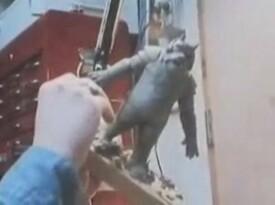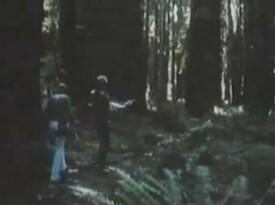From Star Wars to Jedi
A look back at this vintage documentary



I remember it was Christmas, 1990. Me and my family were opening presents and my dad handed one off to my mom which turned out to be the current VHS releases of the Star Wars trilogy. Man, was I ever jealous. But eventually I got around to opening a present for myself which wasn't quite the same thing, but not a bad substitution at all. It was a VHS copy of the documentary From Star Wars to Jedi: The Making of a Saga.

I wound up watching that thing almost as religiously as the trilogy itself, as I've always been fascinated with behind the scenes movie magic. Eventually the tape wore out and I hadn't seen the documentary for well over a decade up until just recently when I found a copy online, and felt inspired to put together a retrospective on some of its best moments.




The documentary was produced in 1985 and features narration by Mark Hamill. The title is a little misleading, as an overwhelming majority of it is exclusively about Return of the Jedi, but it still possesses an intriguing overview on how special effect-based films were done in the old days, long before the unfortunate overtake by CGI.




After a brief synopsis of the trilogy's story, the documentary dives into behind the scenes of creature creation. According to the documentary, more than eighty creatures lurked in the shadows of Jabba's Palace. They talk about the creature concepts' evolution by a team of fifteen artists who spent thirteen months transitioning from maquettes to full scale masks and puppets.




"Well over a million dollars was spent on creature development and construction."
This quote I found to be quite interesting, considering by comparison the massive amounts of money spent for all-CGI presentations made these days, how times have changed. Another intersting moment happens in footage of Lucas visiting the creature designers to talk about Sy Snootles and how they're going to make her sing.




"The thing is, it doesn't have to be articulate, all it has to do is be able to open and close."
These days for sure Lucas would be more worried about articulation, and considering the original Sy Snootles puppet was completely elimitated from his "definative special edition version" only backs that theory up. When you get to take a look at all the work that went into the full scale puppetry of Sy Snootles it makes you wonder why it would all just be thrown away many years later.






The documentary then begins talking about the creation of Jabba, through his many maquette designs to becoming at the time the largest, most complex puppet ever built for a movie. The 2,000 pound result took three months to build at a price of half a million dollars. Here you also get to see the five crewmembers involved in all the puppeteering of Jabba down to the guy with the easiest job of blowing cigar smoke through a tube to simulate Jabba's pipe smoking.




Next, they talk about the creation of the Rancor, from unsuccessful tests of Phil Tippet in a monster suit, to scaling the Rancor down to an eighteen-inch puppet photographed in slow motion to create the illusion of massive size. Even Lucas himself can admit the result was brilliant and hopefully he'll never alter the footage to CGI in later releases of the film.

They then talk about the creation of the Sail Barge/Sarlaac set. The barge itself was 212 feet long and 80 feet high, built over a four-month period by nearly 100 crewmembers. At the time, this was one of the largest sets ever created until Titanic (1997), which was over three times as big. This part of the documentary has a great moment of George Lucas interviewed where he says the following:

"One of the fatal mistakes that almost every science fiction film makes is that they spend so much time on the settings, you know, creating the enviroment, that they spend film time on it. And you don't have to spend too much film time to create an enviroment. What they're doing is showing off the amount of work that they generated. And it slows the pace of the film down. The story is not the setting, the story is the story, the plot."
Wow. The sheer irony of this statement is hilarious considering the kind of filmmaker Lucas has become over the last decade. Makes you wonder how someone with high principles like this can change so much over time.






The next part of the documentary covers the creation of the speeder bike sequence. The background source footage was shot in the redwood forest of Northern California at two frames per second to create the illusion of massive speed. One of the funniest aspects of this part of the documentary is seeing the animatic footage with action figures.

It becomes evident at one point in this documentary that despite what he may say these days, George Lucas conceived the storyline of the Star Wars trilogy as he went along, without much pre-conception. When the documentary talks about the introduction of Yoda, the interview footage of Lucas has him pretty much admitting he prematurely killed off Obi-Wan and wound up painting himself into a corner. Yoda wasn't even in his mind until a couple script revisions in of The Empire Strikes Back. I'm sure today he wants that interview footage destroyed as much as the entire ill-conceived Holiday Special.

All in all, this is still a good documentary to this day, despite its dated feel. If you're as big into vintage special effects creation as I am, it's a must see. So, in closing, I'll leave you with one more of Lucas' amusingly ironic quotes from the documentary:

"Special effects are just a tool, a means of telling a story. People have a tendency to confuse them as an end to themselves. A special effect without a story is a pretty boring thing."




Next, they talk about the creation of the Rancor, from unsuccessful tests of Phil Tippet in a monster suit, to scaling the Rancor down to an eighteen-inch puppet photographed in slow motion to create the illusion of massive size. Even Lucas himself can admit the result was brilliant and hopefully he'll never alter the footage to CGI in later releases of the film.

They then talk about the creation of the Sail Barge/Sarlaac set. The barge itself was 212 feet long and 80 feet high, built over a four-month period by nearly 100 crewmembers. At the time, this was one of the largest sets ever created until Titanic (1997), which was over three times as big. This part of the documentary has a great moment of George Lucas interviewed where he says the following:

"One of the fatal mistakes that almost every science fiction film makes is that they spend so much time on the settings, you know, creating the enviroment, that they spend film time on it. And you don't have to spend too much film time to create an enviroment. What they're doing is showing off the amount of work that they generated. And it slows the pace of the film down. The story is not the setting, the story is the story, the plot."
Wow. The sheer irony of this statement is hilarious considering the kind of filmmaker Lucas has become over the last decade. Makes you wonder how someone with high principles like this can change so much over time.






The next part of the documentary covers the creation of the speeder bike sequence. The background source footage was shot in the redwood forest of Northern California at two frames per second to create the illusion of massive speed. One of the funniest aspects of this part of the documentary is seeing the animatic footage with action figures.

It becomes evident at one point in this documentary that despite what he may say these days, George Lucas conceived the storyline of the Star Wars trilogy as he went along, without much pre-conception. When the documentary talks about the introduction of Yoda, the interview footage of Lucas has him pretty much admitting he prematurely killed off Obi-Wan and wound up painting himself into a corner. Yoda wasn't even in his mind until a couple script revisions in of The Empire Strikes Back. I'm sure today he wants that interview footage destroyed as much as the entire ill-conceived Holiday Special.

All in all, this is still a good documentary to this day, despite its dated feel. If you're as big into vintage special effects creation as I am, it's a must see. So, in closing, I'll leave you with one more of Lucas' amusingly ironic quotes from the documentary:

"Special effects are just a tool, a means of telling a story. People have a tendency to confuse them as an end to themselves. A special effect without a story is a pretty boring thing."
17
Login To Vote!
More Articles From taciturnwes
























Comments
14